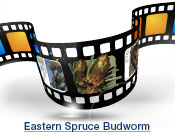| |
Spruce Budworm - Forest Health and Adaptation | |
| |
|
|
| |
|
|
| |  {GFX-ESRDx-ForestHealth-EasternBudworm-Slide2.jpg}{GFX-ESRDx-ForestHealth-EasternBudworm-Slide3.jpg}{GFX-ESRDx-ForestHealth-EasternBudworm-Slide4.jpg}{GFX-ESRDx-ForestHealth-EasternBudworm-Slide5.jpg}Eastern Spruce Budworm {GFX-ESRDx-ForestHealth-EasternBudworm-Slide2.jpg}{GFX-ESRDx-ForestHealth-EasternBudworm-Slide3.jpg}{GFX-ESRDx-ForestHealth-EasternBudworm-Slide4.jpg}{GFX-ESRDx-ForestHealth-EasternBudworm-Slide5.jpg}Eastern Spruce Budworm
Eastern spruce budworm (Choristoneura fumiferana [Clemens]), is an important, common forest insect in Alberta. It usually feeds on mature conifer trees, including white and black spruce and balsam fir. In Alberta, it prefers spruce over fir trees.
Depending on the time of year, this insect may be found as a moth (adult) or a caterpillar (larva). Spruce budworm caterpillars damage trees by feeding on the buds, flowers and young needles.
Found throughout Alberta, including cities and towns, larger outbreaks generally occur in the boreal forests of northern Alberta.
Signs and Symptoms
Look for the following signs and symptoms of eastern spruce budworm infestation:
Branches/Twigs/Shoots
- Dieback
- Presence of larvae and/or brown-grey pupal cases
- Webbing/frass
Cones
Crown
- Thinly foliated, fading green or yellow-orange (tamarack trees) or red-brown in July and August
- Silky webbing
Foliage/Buds
- Bud caps retained
- Fading green-yellow (tamarack trees) or red-brown needles
- Mature larvae (18 -- 24 mm long) with:
- brownish bodies
- black heads
- two rows of paired white spots along side
- 3 pairs of thoracic legs and 5 pairs of abdominal prolegs
- Mined needles and buds
- Partly chewed needles (especially current year's growth)
- Webbing/frass
Similar Damage
- Can be confused with other budworms, bud-feeding moths and sawflies.
- Look for larvae (May to June), pupal cases, webbing, frass, and buds with retained caps late in the season.
- In order to distinguish from 2-year cycle budworm, population cycles over several years may have to be observed.
Western Spruce Budworm
Western spruce budworm (Choristoneura occidentalis) occasionally occurs in southwestern Alberta. This insect feeds primarily on Douglas-fir, but will feed on other tree species such as the true firs, larch and to a lesser degree, spruce.
Depending on the time of year, this insect may be found as a moth (adult) or a caterpillar (larva). Spruce budworm caterpillars damage trees by feeding on the buds, flowers and young needles.
Signs and Symptoms
Look for the following signs and symptoms of western spruce budworm infestation:
Branches
- Caterpillars found in late May to early July on the tips of branches
- Defoliation or removal of the new needles on the tips of branches
Crown
- Rusty brown tree crowns in July, caused by the dead brown needles and pupal cases becoming entangled in silken webbing
Foliage/Buds
- Silken webbing seen in May/June around needles and shoots
|
|
| |
|
|
| |
For more information about the content of this document, contact Devon Belanger.
This information published to the web on February 24, 2016.
|
|